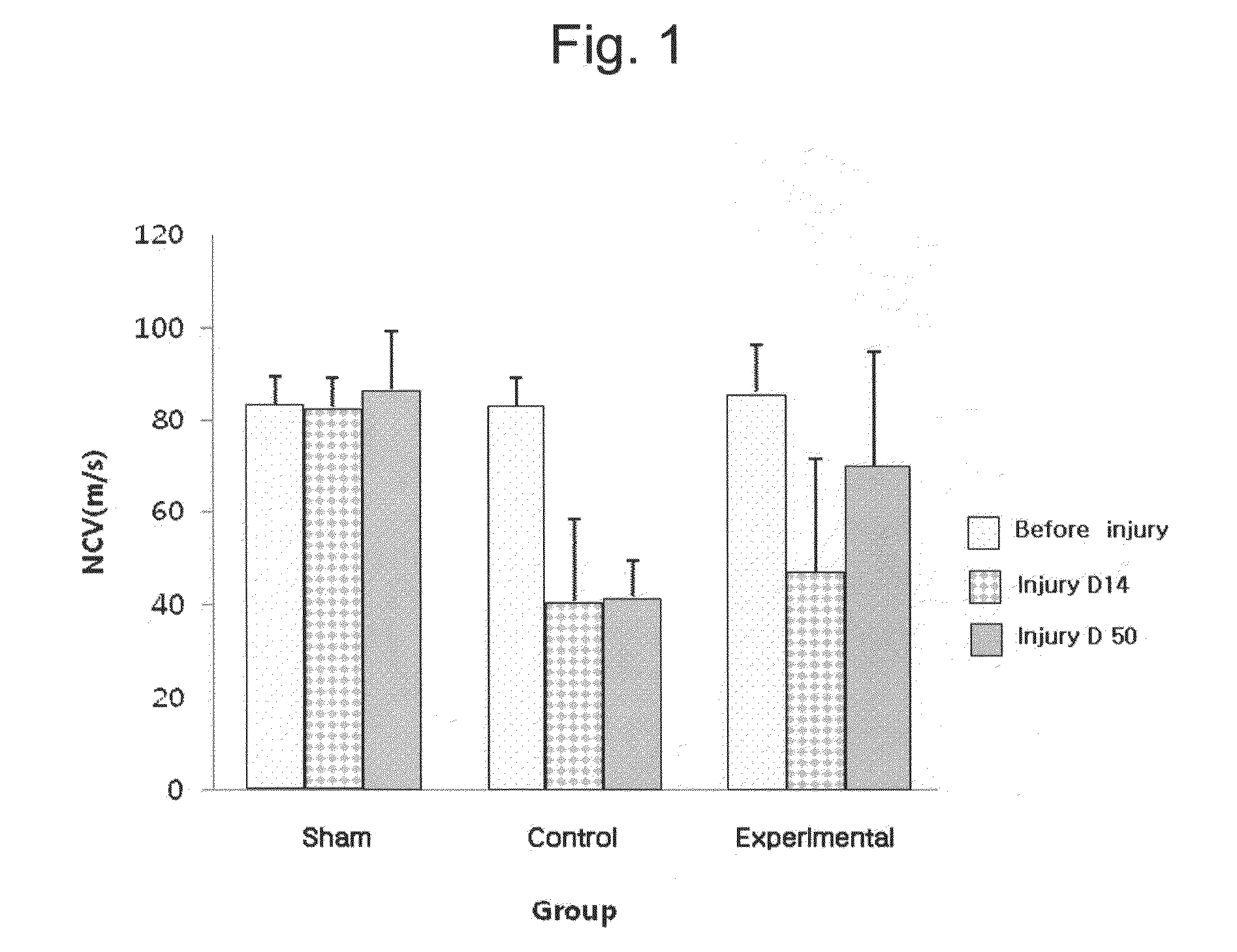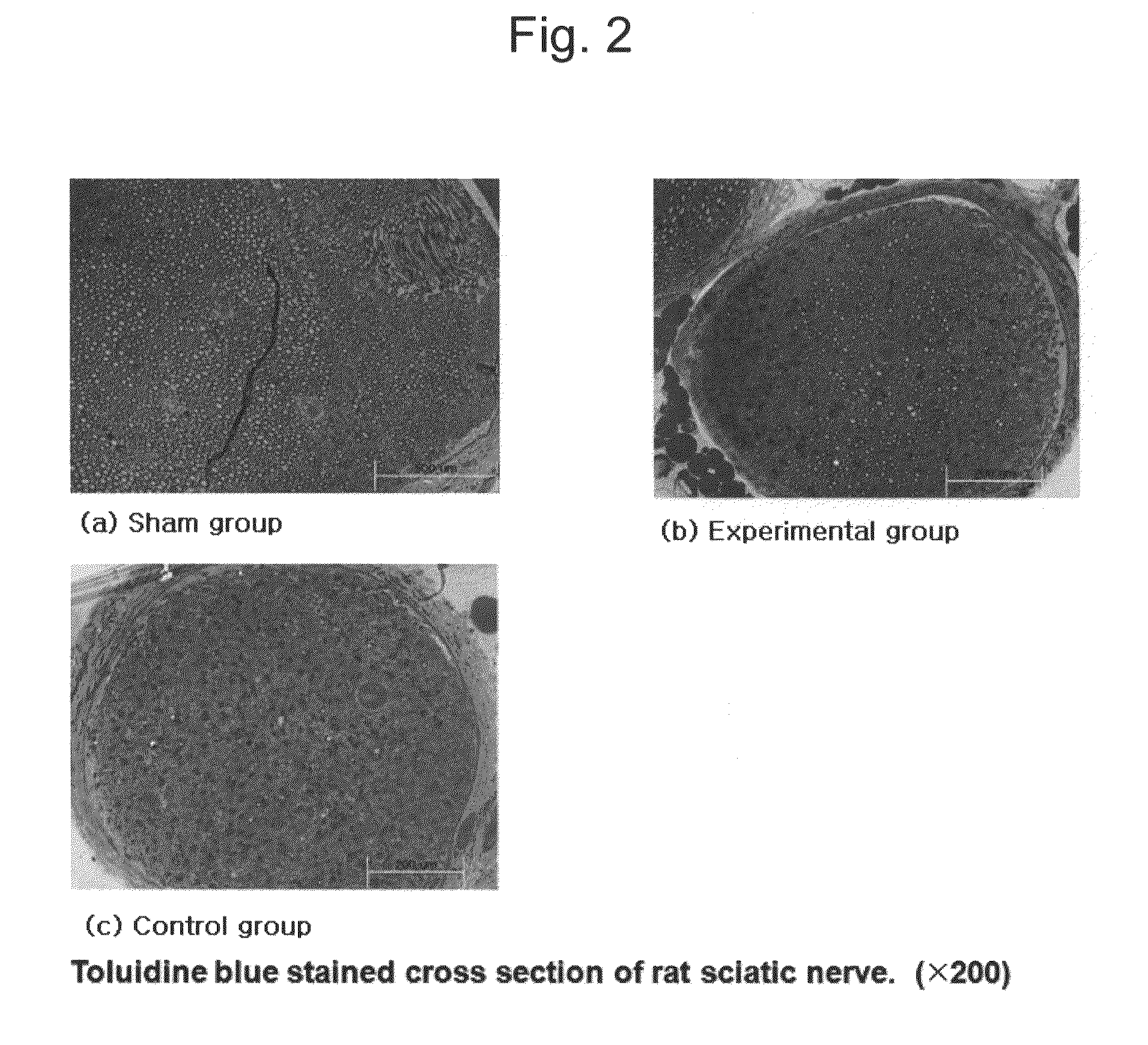Method for treating pain induced by traumatic peripheral nerve injury by administration of G-CSF
a peripheral nerve and traumatic technology, applied in the field of traumatic peripheral nerve injury agents, can solve the problems of no research that recognizes the treatment of traumatic peripheral nerve injuries, peripheral nerves may be injured, etc., and achieve the effect of relieving nerve injury pain and improving nerve conduction velocity
- Summary
- Abstract
- Description
- Claims
- Application Information
AI Technical Summary
Benefits of technology
Problems solved by technology
Method used
Image
Examples
experimental example 2
Nerve Conduction Test
[0055]The nerve conduction test was performed after SD rats were anesthetized with a mixed solution of ketamine and xylazine. The sciatic notch was selected as the stimulated site, an active-recording electrode was placed on the leg muscles, a counter electrode was placed on the foot, and a ground electrode was placed between a stimulating electrode and a recording electrode. An adhesive electrode was used as the recording electrode and a pin electrode as the ground electrode was placed on the subcutis.
[0056]The nerve conduction test was performed with KeyPoint (Dantec, Denmark). The frequency, sweep velocity, and sensitivity were 2 to 10,000 Hz, 2 msec / division, and 5 mV / division, respectively. The nerve conduction test was performed before operation, on the 14th day after the operation (injury D14) and on the 50th day after the operation (injury D50). For the test, the latency and width were determined by measuring onset latency, and the width from a base line...
experimental example 3
Histopathological Examination
[0060]On the 50th day after operation (injury D 50), sciatic nerve tissues of each group were extracted in order to identify the tissue variation and neurohistological examination was performed using toluidine blue staining. The results thus obtained are shown in FIG. 2.
[0061]As can be seen from FIG. 2, as compared to the control group (saline-administered group), the experimental group (G-CSF-administered group) had a great deal of normal tissues similar to the sham group, which indicates that nerve tissues were regenerated.
experimental example 4
Behavior Test to Cold Allodynia
[0062]Whether or not cold allodynia was observed on 1, 2, 6, 8, 10, 14, 20, 27, 31, 38, 42, 45 and 50th days after operation, was confirmed.
[0063]Specifically, pain in response to cold stimuli was measured by dropping acetone on the plantar of the injured leg to perform avoidance response (Tal et al., Onset of ectopic firing in the Chung model of neuropathic pain coincides with the onset of tactile allodynia, Proceedings of the 11th World Congress on Pain). The acetone was dropped on the plantar of the injured leg five times at five-minute intervals using a polyethylene tube connected to a syringe. The response frequency (%) was determined by dividing the leg avoidance frequency by the total number of tests and calculating as a percentage. The results thus obtained are shown in FIG. 3.
[0064]As can be seen from FIG. 3, the normal group (sham group) was not injured by operation, but felt pain by the operation. As compared to the control group (saline-adm...
PUM
| Property | Measurement | Unit |
|---|---|---|
| temperature | aaaaa | aaaaa |
| skin temperature | aaaaa | aaaaa |
| skin temperature | aaaaa | aaaaa |
Abstract
Description
Claims
Application Information
 Login to View More
Login to View More - R&D
- Intellectual Property
- Life Sciences
- Materials
- Tech Scout
- Unparalleled Data Quality
- Higher Quality Content
- 60% Fewer Hallucinations
Browse by: Latest US Patents, China's latest patents, Technical Efficacy Thesaurus, Application Domain, Technology Topic, Popular Technical Reports.
© 2025 PatSnap. All rights reserved.Legal|Privacy policy|Modern Slavery Act Transparency Statement|Sitemap|About US| Contact US: help@patsnap.com



